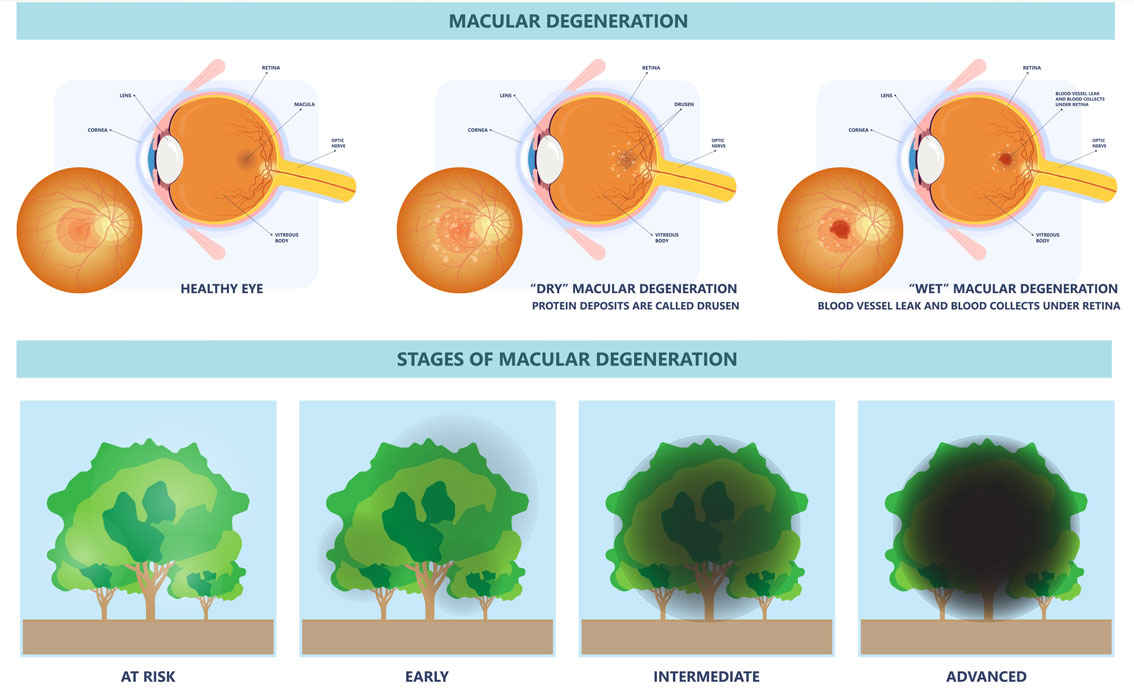Six Things You Should Know About Age Related Macular Degeneration
Dr. Elisa Fiorentino, Optometrist
Age-related macular degeneration (AMD) is the leading cause of severe, permanent vision loss over the age of sixty. Understanding the signs and symptoms, proper monitoring, early detection, and timely treatment are all key to preserving your vision.

What is AMD?
AMD affects the macula, which is the area in the retina at the back of the eye that is responsible for clear central vision. In the early form of AMD, otherwise known as dry AMD, proteins, and lipids deposit under the retina, causing it to eventually break down. Dry AMD is more common and usually progresses slowly over several years. Approximately ten to fifteen percent of patients with dry AMD end up developing a more advanced form of the disease known as wet AMD. In wet AMD, abnormal blood vessels grow in the retina and leak fluid. This type of AMD is more likely to cause a sudden change in vision resulting in serious vision loss.
AMD is not curable, but there are treatment options and ways to reduce your risk to help slow the progression.
What are the risk factors?
Age is the biggest risk factor associated with AMD. As you age, your risk of developing AMD increases. One in seven people over fifty years of age have signs of the disease. By the time you are seventy-five, your risk increases to nearly one in three. Another significant risk factor is family history. Your risk of developing AMD is three to four times higher if your parent or sibling has the disease.
Other risk factors include smoking, UV exposure, unhealthy diet, race (Caucasian), high blood pressure, diabetes, and obesity. Generally speaking, having a healthy lifestyle can help to reduce your risk of developing this disease.
What are the symptoms?
Dry AMD can affect one or both eyes. If only one eye is affected, you may not notice any changes in your vision at first. There is no physical pain associated with AMD. In cases of dry AMD, symptoms usually develop gradually and include reduced central vision, distorted vision, the need for brighter light or blurred vision when reading, trouble adapting to low light levels, and difficulty recognizing faces. Wet AMD is characterized by a blind or distorted spot in your central vision that appears suddenly.
Therefore, people whose eyes are impacted by this disease may have difficulty with tasks such as reading and driving but maintain good peripheral vision.
How is AMD diagnosed?
Your optometrist will review your medical and family history and conduct a thorough examination of the macula. Early signs of the disease can often be detected during an eye examination before symptoms appear.
At Transcona Optical, we not only use traditional methods to view inside the eye, but we have advanced technology that provides images of the central retina in utmost detail. One of our most invaluable diagnostic imaging tools is Optical Coherence Tomography (OCT). This non-invasive imaging displays detailed cross-sections of the macula, much like an ultrasound image. Examining the layers of the macula with this state-of-the-art technology assists us in the diagnosis of AMD and helps us determine the best treatment plan for a patient.
If you have AMD, how often do you need eye exams?
It is very important to have regular follow-ups if you have been diagnosed with macular degeneration. Based on the stage of the disease, your optometrist or ophthalmologist will determine how often your eyes should be examined. You will also likely be shown how to monitor for sudden changes at home with an Amsler Grid test (a series of vertical and horizontal lines). By looking at the grid on a regular basis, you should be able to tell if there are changes to your central vision which require prompt attention. Often sudden changes indicate that dry degeneration has advanced to wet degeneration.
What are the treatments for AMD?
The treatment of AMD depends on the stage and type. Currently, there is no treatment for early dry AMD. Routine eye exams with your optometrist are advised to monitor progression. Eating healthy, getting regular exercise, wearing proper sunglasses, and quitting smoking can also help. In most cases of dry AMD, certain supplements (vitamins and minerals) are often prescribed. If you have wet AMD, there are treatments that may be able to stabilize vision loss which include injectable medications that help to reduce the fluid at the back of the eye. This treatment is performed by an ophthalmologist when required.
Knowing how to protect your eyes and following a healthy lifestyle can reduce your risk of permanent retinal damage and vision loss. As research continues, we have a better understanding of the causes of macular degeneration. With that will come the development of future treatments for AMD that will make it more manageable for those who are affected by this disease.


